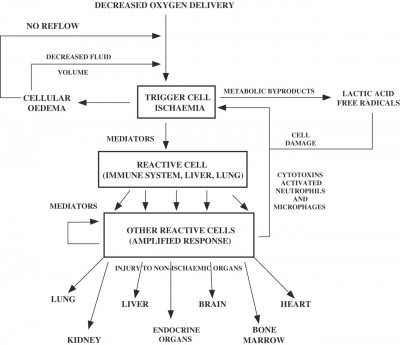
Yet another model
The common thread that defines the shock process is inflammation.
As we know, inflammation is the body’s response to damage. When things go wrong, when trouble calls, we ring the bell for inflammation to make it right. Often this serves us well, but like any militia, if left unchecked it can be worse than the problem it came to fix.
The many twists and turns of the pathology of shock are still not fully understood, but here are some of the important stepping stones along the way:
Shock occurs, and many of the body’s systems are left without adequate oxygen. Although oxygen supplies our primary method of generating energy — the aerobic metabolism — we do have secondary systems in place that can produce energy without oxygen, the anaerobic cycles. In the setting of shock, these take over.
But they’re not great. They provide far less energy than aerobic metabolism, and they produce by-products that accumulate in the body. Among other things, this includes the accumulation of hydrogen ions, creating a widespread acidosis. Think about running sprints or lifting heavy weights; think about that burning feeling, and the eventual failure of your muscles. Operating in an anearobic mode causes trouble and is shortlived at best.
Sooner or later, this isn’t enough to keep things working, and cells begin to accumulate toxic products and eventually shut down. They’re not quite dead yet; they’re hurting, but they can still recover. Like a business that shuts its doors in the off-season, there simply isn’t enough inflow for them to operate right now.
The trouble is, we need those cells. They make up the tissues that form the heart, the brain, the lungs, the kidneys, the liver, and so forth. When the cells close up shop, the organs begin to fail. When organs fail, they cease to provide their essential functions. Let’s consider just one, the heart.
The heart pumps blood. When it loses its effectiveness, it pumps less blood. This means less circulation of oxygen, which means hypoxia is exacerbated. Look at that — we just magnified the problem. If the shock gets worse, is that going to help the heart pump any better? Dream on. The vicious cycle accelerates further.
As hypoxic damage to the cells progresses, the body responds with widespread inflammation to repair it. The trouble is, there’s no real hope of repairing anything without restoring the oxygen supply — but that never stopped Old Man Inflammation. One of his brute-force tactics is to increase capillary permeability, the “tightness” of tissues; everything becomes more susceptible to leakage. The fluid that runs throughout your body begins to ooze everywhere. Generalized edema occurs. In some cases, this is just gross; look at the bloated extremities of the recently dead for an example. But what happens when there’s edema and inflammation of the vital organs? They fail. Fluid in the lungs impairs respiration. Fluid in the brain causes increased intracranial pressure. Another blind response of the inflammatory system is apoptosis, where hypoxic cells — sensing that they’re done for — trigger self-destruct mechanisms and tear themselves apart. Unfortunately, you need those cells.
And hey, what about that acidosis? Our cells (including the ligand-receptor complexes that trigger our sympathetic processes) are designed to function at a specific pH. Placing them in an acidotic environment impairs their function. Combo attack!
But what about our compensatory systems? When our body sees shock, it does things like vasoconstricting, increasing heart rate and contractility, and attempting to maximize the availability of oxygen. That’s great when it works. But when things progress, it’s not so great. Vasoconstriction can choke off the organs, giving them even less oxygenated blood. Tachycardia increases the heart’s demand for oxygen.
And oh, by the way, none of this is adds much to the body’s ability to combat the original cause of the shock, whether that was traumatic injury, a septic infection, or something else.
Key points:
- The processes of shock are multiple and self-reinforcing.
- Inflammation plays a major role.
- Multi-organ dysfunction and failure also plays a major role.
Next time: so what do we do about it?


Speak Your Mind